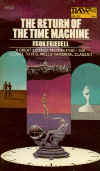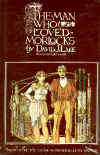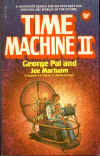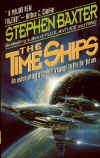To see reviews by Sandra
Petojevic of each book, click on each picture!
Last update of these links August 28, 2005
 The Return of The Time Machine by Egon Friedell
The Return of The Time Machine by Egon Friedell
Review
by John Q
McDonald --- 3 September 1998
In this DAW publication, the editor declares
that Friedell may have been a correspondent with H. G. Wells, author of
the science-fiction classic, The Time Machine. The novel opens
with the author reproducing letters between him and Wells' secretary,
but the overbearing grouchiness of the letters surely belies that possibility.
The book sets out to be a faithful sequel to Wells' story of a man traveling
into the distant future only to find the horrific outcome of a divided
society. Grouchy is the best word to describe this book. The tone of the
writing, the unprovoked barbs at English culture and several poets, and
the characters themselves, all express a "curmudgeonliness"
not seen in the first book. The story itself is not a very good sequel,
dwelling on "scientific" details of the time travel, leaving
what the traveller finds almost a footnote. There are fair attempts at
describing the world of the future, and the difficulties in traveling
into the past, but the whole lacks the cohesiveness of Wells' work. The
story fails, not only to be consistent with The Time Machine,
but to be consistent with itself. Perhaps the book serves as an oddity
in time travel stories, but it isn't a very good book. 
 The Man Who Loved Morlocks by David Lake, illustrated
by Steph Campbell
The Man Who Loved Morlocks by David Lake, illustrated
by Steph Campbell
 Morlock Night by K. W. Jeter
Morlock Night by K. W. Jeter
 Time Machine II by George
Pal and Joe Morhaim
Time Machine II by George
Pal and Joe Morhaim

 The
Time Ships by Stephen Baxter The
Time Ships by Stephen Baxter
Rebuilding
the Time Machine: The Science of H.G. Wells
by
Stephen Baxter
"Long ago I had a vague
inkling of a machine... that shall travel indifferently in any
direction of Space and Time, as the driver determines."
Filby contented himself with laughter.
"But I have experimental verification," said
the Time Traveller...
The
Time Machine, Chapter 1.
The Time Machine, by HG Wells, is 100 years
old in 1995; and it remains a wholly remarkable book. It is the story
of an unnamed Victorian scientist/adventurer who builds a bicycle- like
Time Machine and uses it to explore a dark future: a world of Eloi and
Morlock, of degraded humanity. The Time Traveller returns to the 1890s
to leave an account of his voyage, and then, at the end of the book, sets
out on his Machine once more... and never returns.
Like many readers, I've always longed to
know what happened to the Time Traveller! - and now, able to stand it
no longer, I've written my own sequel to Wells's book, called The Time
Ships. And one of my pleasures in researching my novel has been to reexamine
the scientific basis of the Time Machine itself, in the light of 1990s
physics.
Academic research is very different to
researching a science fiction novel. I should know; I have a yellowing
PhD in acoustical engineering, as well as six published sf novels, to
my name. So how does a writer of sf go about researching a topic like
Time Travel?
The best sf comes from the edge of current
understanding, where there tend, unfortunately, to be no helpful popular
overviews. And - naturally - the more recent papers are, the more they
tend to disagree. To research, it helps to have access to a good science
library: papers can be obtained through inter-library services or, in
some cases, on-line; but you can't browse that way, and browsing is important.
And, if your topic is something to do with the physical sciences, understanding
maths well enough to be able to ignore the equations is a bonus.
When I started to dig into Time Travel,
I quickly found that - remarkably enough - modern physicists have dreamed
up several ways for Time Machines to work. (A good popular overview is
John Gribbin's In Search of the Edge of Time.) Following the work of Kip
Thorne and fellow workers at Cal Tech since the early 1980s, most of these
paper travellers journey in spacecraft through fixed wormhole time tunnels
(see New Scientist's "Wormholes, Time Travel and Quantum Gravity",
28 April 1990).
Every so often objections are raised about
the physical plausibility of this scenario. For instance, recently Stephen
Hawking pointed out that any time-bridging wormhole would quickly suffer
a catastrophic energy leakage, caused by radiation feeding back on itself
through the wormhole. But to each objection a counter is quickly found:
in Hawking's case, Li-Xin Li of Beijing has come up with a way to stop
the feedback using a spherical mirror placed close to the wormhole ("Time
Travel: It's All Done with Smoke and Mirrors", New Scientist, 4 February
1995).
So the physicists keep on coming up with
plausible ways to construct time tunnels, and their main problem is how
to resolve the consequent granny-strangling causality paradoxes. The main
get-out clause at the moment seems to involve the quantum physics idea
of multiple universes, with a new world- line being created each time
history is adjusted.
Unfortunately for me and H.G., however,
a constraint of researching sf is that the science has to fit the fiction.
And a Kip Thorne time tunnel just wouldn't suit our fictive purposes.
Wells's Time Machine was more like the Tardis: a device you sit inside,
and press levers to freewheel through Time. Not a wormhole in sight.
As I dug further in the literature, though,
I found another promising lead. It seems that there are particles which
can, conveniently, move backwards in time without the assistance of tunnels:
antiparticles, like positrons. But this wouldn't do either: annihilating
the Time Traveller and rebuilding him in antiparticles would surely require
the entire mass-energy of 1890s Richmond as fuel!
And besides, I needed to build on Wells's
own rationale. The Time Traveller says: There are really four dimensions,
three which we call the three planes of Space, and a fourth, Time... (The
Time Machine, Chapter 1.) According to Wells, the Machine works by traversing
a 'distance' in a fourth Time direction, just as conventional vehicles
can traverse Space. So the Machine, evidently, somehow 'twists' the axes
of Space and Time.
(The history of Wells's novel is interesting
on this point. Space-time geometry was in the air in 1895: Lorentz and
Fitzgerald had already published space-bending hypotheses to explain the
celebrated Michelson-Morley light-speed experiments (roughly speaking,
rulers are shortened and clocks slowed to make light-speed come out at
a constant value). But, nevertheless, Wells was writing a decade before
the publication of Einstein's first Special Relativity papers. Wells seems
to have been the first anywhere to express Time as a geometric dimension.
And considering that such Time Travel stories as preceded Wells's had
featured such 'justifications' as angels and reincarnations, Wells's perception
seems all the more remarkable.)
How could I extrapolate from this to rebuild
the Time Machine?
I went back to Einstein. How can Space-time
get twisted? Well, rotating matter - according to General Relativity -
does twist axes: matter currents drag at Space-time with gravitational
fields, rather as electrical currents exert magnetic forces.
This seemed a promising lead. And in fact, Frank
Tipler (Physical Review D, vol 9, p 2203 (1974)) has described a mechanism
for Time Travel involving paths around an infinitely long cylinder, spinning
so fast that its surface moves at more than half the speed of light. Unfortunately
for me, such an artifact might have been conspicuous in Victorian Richmond.
At last I came across a more satisfying possibility.
In 1949 Kurt Goedel, working with Einstein at Princeton, published a paper
called 'An Example of a New Type of Cosmological Solutions of Einstein's
Field Equations of Gravitation' (Reviews of Modern Physics, vol 21, p
447). Yes, this was the famous Goedel who had already - in 1931, at the
absurdly young age of 25 - proven the incompleteness of mathematics.
Goedel described a rotating universe. In
such a place, if a bullet is fired off from any point, its path will be
swung around by the general spin. In fact, Goedel's Space-time is so distorted
by its spin that it contains paths which loop into the past. In a universe
like ours, such paths would be hundreds of millions of light years long,
but the paths shorten if the general density is higher. (Gribbin's book
has more details.)
At last I had the bones of a rationale!
I imagined the Time Machine dipping into an alternate, dense, fast-rotating
Goedel universe, a few milliseconds at a time, and so spiralling into
future or past...
Of course this still requires a certain
amount of hand- waving - for instance, about the existence of the Goedel
universe, and how to get the Machine there and back - but such things
are (comparatively speaking!) mere details. But this mechanism would match,
more or less, Wells's Space-time axis bending. I knew that in the course
of my plot, as the Traveller looped back and forth in Time, altering history,
I would be exploring modern alternate-universe ideas anyway, so the idea
of the additional Goedel universe would fit the framework of the novel.
And as I learned about Goedel himself, I began to see a new subplot opening
up, involving a cameo role for an enigmatic mathematician...
An sf novel is not an academic text. (For
one thing, it's a lot more fun.) In researching for sf, you aren't seeking
completeness and depth; rather, you tend to browse, to use indexes heavily,
to follow your nose. You're looking for the peculiar and interesting,
and for material which will fit the fictional framework of the piece.
As far as accuracy is concerned, the objective is to assemble a reasonable
consensus picture of a subject, thus avoiding any obvious boners in the
text. And a key activity is looking for angles on how to transmit your
findings, painlessly, to the reader.
Wells's purposes in writing The Time Machine
went far beyond scientific extrapolation, of course. His vision of Morlock
and Eloi is a complex myth of man's future, a myth which struck powerful
chords in a culture riven by Darwinism and a new social awareness. And
- as a piece of literature - The Time Machine has often been followed
(including by me!), but never surpassed. But, as with all the best sf,
the myth would have had far less impact without its underpinning by science.
And, in The Time Machine, Wells's science was truly prescient.
But is there any 'experimental verification'
in Wells's text for my Goedel-spinning idea? At the end of The Time Machine,
Wells's narrator watches the Traveller depart: I seemed to see a ghostly,
indistinct figure sitting in a whirling mass of black and brass... but
this phantasm vanished... The Time Machine had gone (Chapter 16).
Whirling, eh? So that is how the Time Machine
worked after all!
� copyright Stephen
Baxter 1995
For
information about George Pal's proposed MOVIE sequel, go HERE.
For another Stephen Baxter
"take" on "The Time Machine," go HERE.
Don
Brockway, Juny 10, 2000 (updated October 12, 2004)
[ The
Book ] [ The
Time Machine Home Page ]
|
